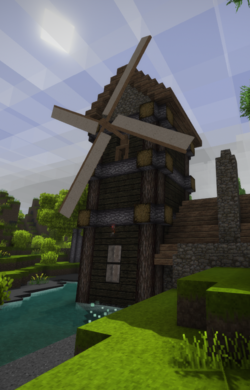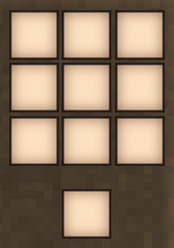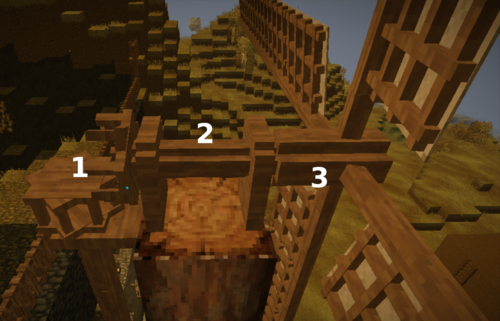Windmill: Difference between revisions
No edit summary |
No edit summary |
||
| Line 1: | Line 1: | ||
[[File:Windmill_Example.png|250px|thumb|Basic windmill attached to a house.]] | |||
A windmill is a multi-block structure used to harness wind and transform it into mechanical power. Currently, wind power can be used to automate [[Quern|querns]] for milling [[Helve hammer |helve hammers]] to work iron blooms or smith metal plates, and [[Pulverizer |pulverizers]] to crush materials into their powdered form. Out of these, only the quern can be used manually, without mechanical power. | |||
__TOC__ | __TOC__ | ||
==Considerations for the Structure== | |||
===Clearance=== | |||
== | A structure with sufficient height and clearance is needed to accommodate the sails, the power train, and associated equipment e.g. quern, helve hammer, etc. Sails too low to the ground may not receive enough wind speed to generate any wind power, likewise, a structure with insufficient clearance might deter the sails from rotating correctly. A windmill can be added onto existing structures as long as it meets the previously mentioned qualifications. | ||
A structure | ===Height and Location=== | ||
The location and height of the structure can also affect the amount of power generated. On a technical level, wind speed varies from region to region and is linearly interpolated between the 4 nearest weather regions, for a given block location. Windspeed will increase by 1% per block above your world's sea level + 10. So if you have a standard world of 256 height, your sea level will be 110. At Y-level 121, you will get 1% additional wind speed. The maximum bonus is 50%. | |||
The location and height of the structure | Conversely, wind speeds below sea level are reduced 50% at 4 blocks below and 66% at 8 blocks below, rapidly decreasing towards 100% reduction. Note that wind speeds will naturally vary at times and there may be no wind at all at other times. | ||
Conversely, wind speeds below sea level are reduced 50% at 4 blocks below and 66% at 8 blocks below, rapidly decreasing towards 100% reduction. | |||
Note that wind speeds will naturally vary at times and there may be no wind at all at other times | |||
== | ==Materials== | ||
To create a windmill, a player needs | To create a windmill, a player needs: | ||
===Windmill rotor=== | |||
The mechanism that supports the rotating sails. Each windmill requires one rotor to work, and each rotor can support up to 5 sets of sails. | |||
{{Crafting | |||
|Ingredients= Any [[Hammer|hammer]] +<br /> Any [[Chisel|chisel]] +<br /> Any [[Trees|log]] (2x) +<br /> [[Resin]] +<br /> [[Fat]] | |||
|Grid/CraftingCode={{Grid/Crafting | |||
< | |||
{{Grid/Crafting | |||
|A1=|B1=Copper hammer|C1= | |A1=|B1=Copper hammer|C1= | ||
|A1N=|B1N=|C1N= | |A1N=|B1N=|C1N= | ||
| Line 30: | Line 24: | ||
|A3N=|B3N=2|C3N= | |A3N=|B3N=2|C3N= | ||
|Output=Windmill Rotor|OA=}} | |Output=Windmill Rotor|OA=}} | ||
{{Grid/Crafting | }} | ||
===Set of Sails=== | |||
The wind-catching part that allows for the generation and harness of wind power. | |||
{{Crafting | |||
|Ingredients= Sticks (6x) +<br /> Linen (4x) | |||
|Grid/CraftingCode={{Grid/Crafting | |||
|A1=|B1=|C1=Stick | |A1=|B1=|C1=Stick | ||
|A1N=|B1N=|C1N=2 | |A1N=|B1N=|C1N=2 | ||
| Line 38: | Line 38: | ||
|A3N=2|B3N=2|C3N= | |A3N=2|B3N=2|C3N= | ||
|Output=Sail|OA=4}} | |Output=Sail|OA=4}} | ||
{{Grid/Crafting | }} | ||
<br> | |||
Sails are constructed in sets, with one set containing four sails, that means each set takes: | |||
{| class="wikitable" | |||
|- | |||
! Sails !! 1 set !! 2 sets !! 3 sets !! 4 sets !! max 5 sets | |||
|- | |||
| Sticks || 6 || 12 || 18 || 24 || 30 | |||
|- | |||
|Linen || 4 || 8 || 12 || 16 || 20 | |||
|- | |||
|} | |||
===Wooden Axles=== | |||
Used to transmit the wind power in a straight line. These may be placed vertically or horizontally in any of the cardinal directions. | |||
{{Crafting | |||
|Ingredients= Any [[Hammer|hammer]] +<br /> Any [[Chisel|chisel]] +<br /> Any [[Trees|log]] +<br /> [[Fat]] | |||
|Grid/CraftingCode={{Grid/Crafting | |||
|A1=Copper hammer|B1=|C1= | |A1=Copper hammer|B1=|C1= | ||
|A2=Copper Chisel|B2=|C2= | |A2=Copper Chisel|B2=|C2= | ||
|A3=Log (Oak)|B3=Fat|C3= | |A3=Log (Oak)|B3=Fat|C3= | ||
|Output=Wooden Axle|OA=}} | |Output=Wooden Axle|OA=}} | ||
{{Grid/Crafting | }} | ||
===Angled Gears=== | |||
Allows the mechanical power to make a right angle turn by connecting a horizontal axle to a vertical one. Usually optional, but often needed depending on the design of the power train. | |||
{{Crafting | |||
|Ingredients= Any [[Hammer|hammer]] +<br /> Any [[Saw|saw]] +<br /> Any [[Chisel|chisel]] +<br /> [[Stick]] (2x) +<br /> Any [[Trees|log]] +<br /> Resin +<br /> [[Fat]] | |||
|Grid/CraftingCode={{Grid/Crafting | |||
|A1=Copper hammer|B1=Copper Saw|C1= | |A1=Copper hammer|B1=Copper Saw|C1= | ||
|A2=Stick|B2=Copper Chisel|C2=Stick | |A2=Stick|B2=Copper Chisel|C2=Stick | ||
|A3=Resin|B3=Log (Oak)|C3=Fat | |A3=Resin|B3=Log (Oak)|C3=Fat | ||
|Output=Angled Gears|OA=}} | |Output=Angled Gears|OA=}} | ||
}} | |||
</div> | </div> | ||
[[File:Example Mill.png|500px|right|thumb|1. Angled Gears. 2. Wooden Axle. 3. Rotor with Sails]] | |||
== Building the Windmill == | |||
The windmill requires at least 5 blocks of vertical space between the rotor and the ground or any other solid block to accommodate a full complement of 5 sets of Sails. | |||
= | {| | ||
| style="width:60px;"|[[File:Wooden_Axle.png|48px]] [[File:Windmill_Rotor.png|48px]] | |||
| Place one wooden axle on the top or side of the building you’re planning on turning into a windmill. It’s recommended this be the first part to place since it then helps with attaching the rotor to the placed axle, suspending it outside the building. This suspended rotor will allow for the space needed for the sails to rotate adequately | |||
|- | |- | ||
|[[File:Sail.png|48px]] | |||
|Next, sails are added to the rotor in sets of four (one for each windmill blade), making it 20 sails in total. | |||
|- | |- | ||
| | |[[File:Angled_Gears.png|48px]] | ||
| | |Once this setup is complete all that’s left is direct the wind power where you want it, using more axles and angled gears to turn in a right angle if need be. | ||
|} | |||
For power train designs, please see [[Mechanical Power]] | |||
== Video Tutorials == | |||
{| class="wikitable" | |||
|- | |- | ||
! How To Build A Windmill, Increase The Power, & Automate a Quern. !! Simple Gearbox Setup Guide (ENG) !! Explanation of Big Gear usage | |||
|- | |- | ||
| | | <youtube width="400" height="240">7xNEz0aDayk</youtube> || <youtube width="400" height="240">ppsP5speLX4</youtube> || <youtube width="400" height="240">ppsP5speLX4</youtube> | ||
|} | |||
{{Navbox|Vintage Story}} | {{Navbox|Vintage Story}} | ||
Revision as of 15:39, 1 October 2021
A windmill is a multi-block structure used to harness wind and transform it into mechanical power. Currently, wind power can be used to automate querns for milling helve hammers to work iron blooms or smith metal plates, and pulverizers to crush materials into their powdered form. Out of these, only the quern can be used manually, without mechanical power.
Considerations for the Structure
Clearance
A structure with sufficient height and clearance is needed to accommodate the sails, the power train, and associated equipment e.g. quern, helve hammer, etc. Sails too low to the ground may not receive enough wind speed to generate any wind power, likewise, a structure with insufficient clearance might deter the sails from rotating correctly. A windmill can be added onto existing structures as long as it meets the previously mentioned qualifications.
Height and Location
The location and height of the structure can also affect the amount of power generated. On a technical level, wind speed varies from region to region and is linearly interpolated between the 4 nearest weather regions, for a given block location. Windspeed will increase by 1% per block above your world's sea level + 10. So if you have a standard world of 256 height, your sea level will be 110. At Y-level 121, you will get 1% additional wind speed. The maximum bonus is 50%. Conversely, wind speeds below sea level are reduced 50% at 4 blocks below and 66% at 8 blocks below, rapidly decreasing towards 100% reduction. Note that wind speeds will naturally vary at times and there may be no wind at all at other times.
Materials
To create a windmill, a player needs:
Windmill rotor
The mechanism that supports the rotating sails. Each windmill requires one rotor to work, and each rotor can support up to 5 sets of sails.
| Ingredients | Crafting Recipe |
|---|---|
| Any hammer + Any chisel + Any log (2x) + Resin + Fat |
Set of Sails
The wind-catching part that allows for the generation and harness of wind power.
| Ingredients | Crafting Recipe |
|---|---|
| Sticks (6x) + Linen (4x) |
Sails are constructed in sets, with one set containing four sails, that means each set takes:
| Sails | 1 set | 2 sets | 3 sets | 4 sets | max 5 sets |
|---|---|---|---|---|---|
| Sticks | 6 | 12 | 18 | 24 | 30 |
| Linen | 4 | 8 | 12 | 16 | 20 |
Wooden Axles
Used to transmit the wind power in a straight line. These may be placed vertically or horizontally in any of the cardinal directions.
| Ingredients | Crafting Recipe |
|---|---|
| Any hammer + Any chisel + Any log + Fat |
Angled Gears
Allows the mechanical power to make a right angle turn by connecting a horizontal axle to a vertical one. Usually optional, but often needed depending on the design of the power train.
| Ingredients | Crafting Recipe |
|---|---|
| Any hammer + Any saw + Any chisel + Stick (2x) + Any log + Resin + Fat |
Building the Windmill
The windmill requires at least 5 blocks of vertical space between the rotor and the ground or any other solid block to accommodate a full complement of 5 sets of Sails.
For power train designs, please see Mechanical Power
Video Tutorials
| How To Build A Windmill, Increase The Power, & Automate a Quern. | Simple Gearbox Setup Guide (ENG) | Explanation of Big Gear usage |
|---|---|---|
| {{{title}}} | |
|---|---|


